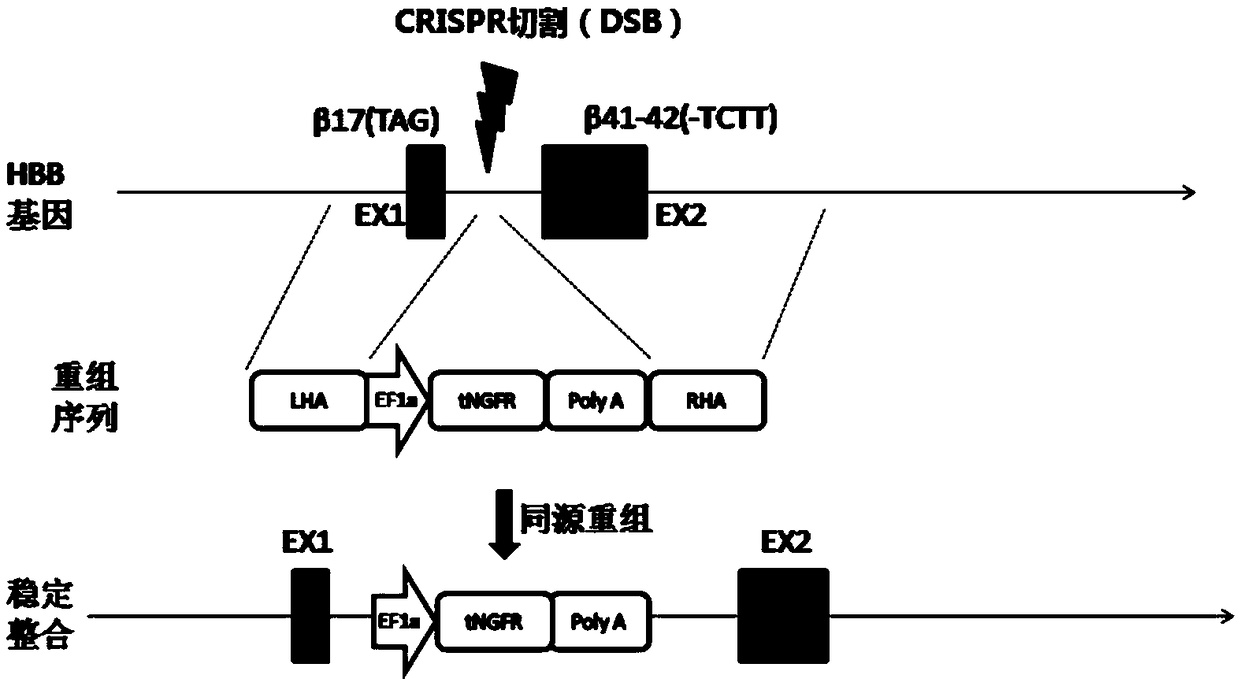gRNA, gene editing system, expression vector and gene editing kit for repairing HBB1 gene point mutation
A gene editing and expression vector technology, applied in the field of gRNA, can solve the problems of low induction rate of iPS cells, high R&D cost, limited clinical application prospects, etc., to avoid matching limitations and immune rejection, and reduce treatment costs.
- Summary
- Abstract
- Description
- Claims
- Application Information
AI Technical Summary
Problems solved by technology
Method used
Image
Examples
Embodiment 1
[0064] Example 1: Cutting the HBB1 gene using the CRISPR-Sp Cas9 gene editing system
[0065] 1.1 gRNA preparation
[0066] (1) Design the target sequence of the gRNA of 20nt according to the HBB1 gene sequence;
[0067] (2) Synthesize the sense strand and antisense strand of the target sequence of gRNA respectively (add cacc at the 5'-end of the sense strand, if the first nucleotide at the 5'-end of the sense strand is not guanine G, then add cacc at the 5'-end of the sense strand Add caccG at the 5'-end; add aaac at the 5'-end of the antisense strand, if the first nucleotide at the 5'-end of the sense strand is not guanine G, add C at the 3'-end of the antisense strand) ;
[0068] (3) The sense strand and antisense strand of the above gRNA were mixed, treated at 90°C, cooled naturally to room temperature for annealing treatment, and the target sequence of double-stranded gRNA with sticky ends was synthesized.
[0069] The positive sense strand of the target sequence of th...
Embodiment 2
[0095] Example 2: Using the CRISPR-Sa Cas9 gene editing system to cut the HBB1 gene
[0096] 2.1 gRNA preparation
[0097] (1) Design the target sequence of the gRNA of 21nt according to the HBB1 gene sequence;
[0098] (2) Synthesize the sense strand and the antisense strand of the gRNA target sequence respectively (add cacc at the 5'-end of the sense strand, if the first nucleotide at the 5'-end of the sense strand is not guanine G, then add cacc at the 5'-end of the sense strand Add caccG at the '-end; add aaac at the 5'-end of the antisense strand, if the first nucleotide at the 5'-end of the sense strand is not guanine G, add C at the 3'-end of the antisense strand);
[0099] (3) Mix the sense and antisense strands of the above-mentioned gRNA target sequence, treat at 90°C, cool naturally to room temperature for annealing, and synthesize double-stranded gRNA with sticky ends.
[0100] The sense strand of the target sequence of the gRNA designed for the HBB1 gene in Tabl...
Embodiment 3
[0125] Example 3 Homologous recombination vector construction and site-directed homologous recombination of HBBI gene
[0126] 3.1 Homologous recombination vector construction
[0127] 3.1.1 Construction of the upstream homology arm vector of SEQ ID NO:17
[0128] (1) Using the HEK293T cell genome as a template, using SEQ ID NO: 29 and SEQ ID NO: 30 as primers to amplify the upstream homology arm of SEQ ID NO: 17, and the PCR product was detected by 1% agarose gel electrophoresis and then recovered by cutting the gel. Purpose Fragment;
[0129] Table 3 HBB1 gene target site SEQ ID NO:17 upstream and downstream homology arms and tNGFR amplification primers
[0130]
[0131] (2) Digest plasmid pDonor-TALEN-EGFP with SnaBI and SalI-HF, digest at 37°C for 1 hour, purify and recover by 1% agarose gel electrophoresis after digestion;
[0132] (3) Homologous recombination was carried out between the above-mentioned digested product and the upstream homology arm PCR product of S...
PUM
 Login to View More
Login to View More Abstract
Description
Claims
Application Information
 Login to View More
Login to View More - R&D
- Intellectual Property
- Life Sciences
- Materials
- Tech Scout
- Unparalleled Data Quality
- Higher Quality Content
- 60% Fewer Hallucinations
Browse by: Latest US Patents, China's latest patents, Technical Efficacy Thesaurus, Application Domain, Technology Topic, Popular Technical Reports.
© 2025 PatSnap. All rights reserved.Legal|Privacy policy|Modern Slavery Act Transparency Statement|Sitemap|About US| Contact US: help@patsnap.com



